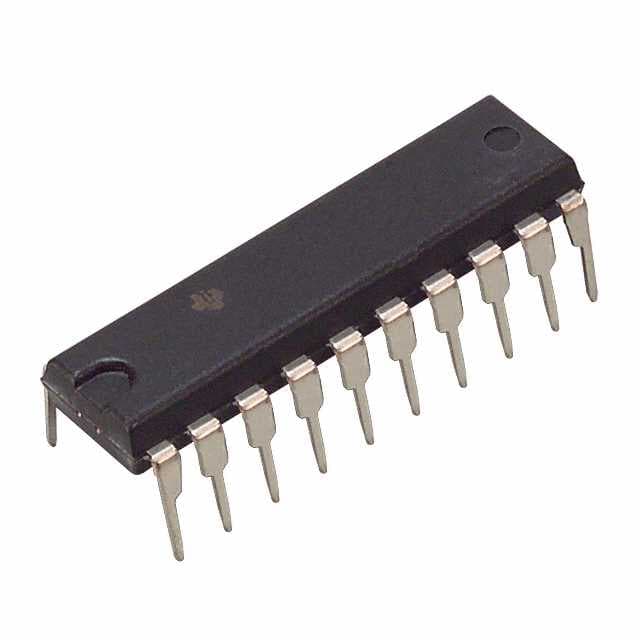Vedi le specifiche per i dettagli del prodotto.

CD74ACT374EG4
Overview
- Category: Integrated Circuit (IC)
- Use: Flip-Flop
- Characteristics: High-speed, low-power consumption
- Package: 20-pin TSSOP (Thin Shrink Small Outline Package)
- Essence: D-type positive-edge-triggered flip-flop
- Packaging/Quantity: Tape and Reel, 2500 units per reel
Specifications
- Supply Voltage: 2V to 6V
- Input Voltage: 0V to VCC
- Output Voltage: 0V to VCC
- Operating Temperature: -40°C to +85°C
- Propagation Delay: 5.5 ns (typical)
- Output Current: ±24 mA
Pin Configuration
The CD74ACT374EG4 has a total of 20 pins. The pin configuration is as follows:
- D0: Data input 0
- D1: Data input 1
- D2: Data input 2
- D3: Data input 3
- D4: Data input 4
- D5: Data input 5
- D6: Data input 6
- D7: Data input 7
- GND: Ground
- Q0: Output 0
- Q1: Output 1
- Q2: Output 2
- Q3: Output 3
- Q4: Output 4
- Q5: Output 5
- Q6: Output 6
- Q7: Output 7
- CP: Clock input
- OE: Output enable
- VCC: Supply voltage
Functional Features
The CD74ACT374EG4 is a D-type positive-edge-triggered flip-flop. It has the following functional features:
- High-speed operation: The CD74ACT374EG4 operates at a fast propagation delay of 5.5 ns, making it suitable for high-performance applications.
- Low-power consumption: This IC is designed to consume minimal power, making it energy-efficient and suitable for battery-powered devices.
- Output enable control: The OE pin allows the user to enable or disable the outputs, providing flexibility in controlling the data flow.
Advantages and Disadvantages
Advantages: - High-speed operation - Low-power consumption - Output enable control for flexible data flow management
Disadvantages: - Limited number of inputs and outputs (8-bit)
Working Principles
The CD74ACT374EG4 operates based on positive-edge triggering. When a rising edge is detected at the clock input (CP), the data present at the D0-D7 inputs is latched and transferred to the corresponding Q0-Q7 outputs. The output enable (OE) pin can be used to enable or disable the outputs as required.
Detailed Application Field Plans
The CD74ACT374EG4 is commonly used in various digital systems and applications, including but not limited to:
- Microcontrollers: Used for storing and transferring data between different parts of the microcontroller.
- Memory Systems: Employed in memory modules to store and retrieve data.
- Communication Systems: Utilized in data transmission and reception circuits.
- Industrial Automation: Integrated into control systems for sequential logic operations.
- Automotive Electronics: Incorporated in automotive control units for data storage and processing.
Detailed and Complete Alternative Models
- SN74ACT374: Similar functionality and specifications, available in different package options.
- MC74ACT374: Equivalent flip-flop IC with comparable characteristics, offered by a different manufacturer.
- 74HC374: Alternative CMOS-based flip-flop IC with similar functionality.
These alternative models can be considered based on specific requirements, availability, and compatibility with the existing system.
Word count: 439 words
10 domande e risposte comuni relative all'applicazione di CD74ACT374EG4 nelle soluzioni tecniche
Sure! Here are 10 common questions and answers related to the application of CD74ACT374EG4 in technical solutions:
Q: What is CD74ACT374EG4? A: CD74ACT374EG4 is a type of octal D-type flip-flop integrated circuit (IC) that can store and transfer data in digital systems.
Q: What is the purpose of CD74ACT374EG4? A: The purpose of CD74ACT374EG4 is to provide a means of storing and transferring data within a digital system, making it useful for applications such as data storage, buffering, and synchronization.
Q: What voltage levels does CD74ACT374EG4 support? A: CD74ACT374EG4 supports a wide range of voltage levels, typically between 2V and 6V, making it compatible with various digital systems.
Q: How many flip-flops are there in CD74ACT374EG4? A: CD74ACT374EG4 contains eight individual D-type flip-flops, allowing it to store and manipulate eight bits of data simultaneously.
Q: What is the maximum clock frequency supported by CD74ACT374EG4? A: CD74ACT374EG4 can operate at high clock frequencies, typically up to 100 MHz, enabling fast data transfer and processing.
Q: Can CD74ACT374EG4 be cascaded to increase the number of flip-flops? A: Yes, CD74ACT374EG4 can be cascaded by connecting the output of one IC to the input of another, allowing for the expansion of the number of flip-flops in a system.
Q: Does CD74ACT374EG4 have any built-in error detection or correction features? A: No, CD74ACT374EG4 does not have any built-in error detection or correction features. It is primarily designed for basic data storage and transfer operations.
Q: What is the power supply requirement for CD74ACT374EG4? A: CD74ACT374EG4 typically operates with a power supply voltage between 2V and 6V, making it compatible with standard digital logic power supplies.
Q: Can CD74ACT374EG4 be used in both synchronous and asynchronous systems? A: Yes, CD74ACT374EG4 can be used in both synchronous and asynchronous systems, depending on the specific application requirements.
Q: Are there any special considerations for PCB layout when using CD74ACT374EG4? A: Yes, it is important to follow proper PCB layout guidelines to minimize noise, ensure signal integrity, and optimize performance when using CD74ACT374EG4. These guidelines may include proper grounding, signal routing, and decoupling capacitor placement.
Please note that these answers are general and may vary based on specific datasheet specifications and application requirements.

